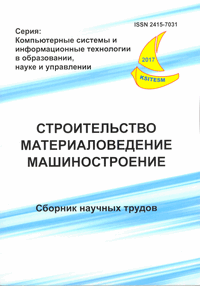Optimization of decisions in the selection of components of fire-protective compositions
Keywords:
flame retardants that bubbled, flameproof, fire, fire resistance of wooden structuresAbstract
Purpose. Development of fire protection composition and investigation of its technological properties: determination of the flood rate and fire protection efficiency group of the proposed coating. Methodology. In the course of the research, an analytical review of the main groups of fire retardants, which increase the fire resistance of wooden building structures, gives an assessment of their technical characteristics, as well as in accordance with DSTU B V.1.1-4-98 "Fire protection. Building constructions. Test methods for fire resistance. General requirements "defines the fire-protective properties of the developed fire protection coating. Findings. Based on optimization of the solutions, the authors developed a composition of flame retardant coating, which forms on a surface, which "protects" a thin non-transparent layer that prevents the inflammation and spread of the flame on a wooden structure. The selection of composition of fire protection composition was carried out according to the scheme "compound - the additive that is flowing - the filler". The basis of the coating is liquid glass, because it has such positive characteristics as accessibility, due to the manifestation of liquid glass adhesive properties - the ability to spontaneous hardening with the formation of artificial silica. Adding to the liquid glass such components as perlite, graphite and epoxy resin, taking into account their positive characteristics regarding the effect of high temperatures, allowed obtaining a new flame retardant composition. The conducted fire tests using the "ceramic pipe" method showed good adhesion of the fire protection coating, a high coefficient of covering up to 270%, as well as a good fire protective ability of the protective coating. Originality. Taking into account the theoretical preconditions, the choice of output components for a new fire protection composition has been carried out. Practical value. A new non-flammable spillway structure is developed, which allows the transfer of combustible materials into a group of heavier and increase fire resistance of building structures. On the developed fireproof composition, the Ukrainian patent for utility model was obtained.References
DSTU B V.1.1-4-98 Zakhist vid pozhezhi. Budivelni konstruktsii. Metodi viprobuvan na vognestiykist. Zahalni vymogy [Protection from fire. Building construction. Test methods for fire resistance. General requirements]. Derzhavnyi komitet Ukrainy z budivnytstva ta arkhitektury [Ukrainian State Committee of construction and architecture]. Kyiv, 1999, 75 p. (in Ukrainian).
Korolchenko A.Ya. and Korolchenko O.N. Sredstva ognezashchity [Means of fire protection]. — Moscow: Pozhnauka, 2006, 258 p. (in Russian).
Orlova A.M. and Petrova E.A. Ognezashchita drevesiny [Fire protection of wood]. Pozharovzryvobezopasnost [The explosion safety]. 2000, Vol. 9, no. 2, pp. 8–17. (in Russian).
Belikov A.S., Safonov V.V., Nazha P.N., Chalyiy V.G., Shlyikov N.Yu., Shalomov V.A. and Ragimov S.Yu. Okhrana truda v stroitelstve [A labour protection is in building]. Kyiv: Osnova, 2014, 592 р. (in Russian).
Belikov A. S., Shalomov V. A., Korzh E. M. and Rahimov S.Yu. Pidvyshchennia vohnestiykosti derevianykh budivel'nykh konstruktsiy za rakhunok znyzhennia horiuchosti derevyny [Increase fire resistance of wooden building structures by reducing the combustibility of wood] Stroitelstvo, materialovedeniye, mashinostroeniye – [Construction, materials science, mechanical engineering]. Dnipro: PDABA, 2017, no. 98, pp. 38-44. (in Ukrainian).
Chernay A.V., Nalisko N.N. and Bartashevskaya L.I. (2017), “Regularities ignition gas mixture the heat source associated with accidental emissions gas”, The scientific heritage (Budapest, Hungary), no. 10(10), vol. 3, pp. 58-66.
Roitman V. M. Fire testing of Bilding Materials in View of the Moisture Factor.— First European Symposium of Fire Safety Sicience (Abstracts). Zurich: ETH, 2005, pp. 135-136.
Downloads
Published
Issue
Section
License
Редакція Видання категорично засуджує прояви плагіату в статтях та вживає всіх можливих заходів для його недопущення. Плагіат розглядається як форма порушення авторських прав і наукової етики.
При виявлені у статті більш ніж 25% запозиченого тексту без відповідних посилань та використання лапок, стаття кваліфікується як така, що містить плагіат. У цьому випадку стаття більше не розглядається редакцією, а автор отримує перше попередження.
Автори, в статтях яких повторно виявлено плагіат, не зможуть публікуватися в усіх журналах Видавництва ДВНЗ «Придніпровська державна академія будівництва та архітектури».
Автори, які публікуються у цьому журналі, погоджуються з наступними умовами:
- Автори залишають за собою право на авторство своєї роботи та передають журналу право першої публікації цієї роботи на умовах ліцензії Creative Commons Attribution License, котра дозволяє іншим особам вільно розповсюджувати опубліковану роботу з обов'язковим посиланням на авторів оригінальної роботи та першу публікацію роботи у цьому журналі.
- Автори мають право укладати самостійні додаткові угоди щодо неексклюзивного розповсюдження роботи у тому вигляді, в якому вона була опублікована цим журналом (наприклад, розміщувати роботу в електронному сховищі установи або публікувати у складі монографії), за умови збереження посилання на першу публікацію роботи у цьому журналі.
- Політика журналу дозволяє і заохочує розміщення авторами в мережі Інтернет (наприклад, у сховищах установ або на особистих веб-сайтах) рукопису роботи, як до подання цього рукопису до редакції, так і під час його редакційного опрацювання, оскільки це сприяє виникненню продуктивної наукової дискусії та позитивно позначається на оперативності та динаміці цитування опублікованої роботи (див. The Effect of Open Access).

